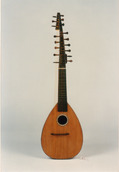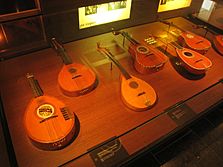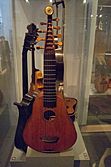Cittern facts for kids

Cittern exhibited at the
Music Museum of Barcelona |
|
| Other names | Fr. cistre, It. cetra, Ger. zitter, zither, Sp. cistro, cedra, cítola |
|---|---|
| Classification | String instrument (plucked) |
| Hornbostel–Sachs classification | 321.322-5 (necked box lute, plucked with fingers) |
| Developed | 16th century |
| Related instruments | |
|
List
|
|
The cittern (also spelled cithren) is a cool stringed instrument from the Renaissance period. It's a bit like a guitar, but it has a long history! People aren't totally sure about its exact beginnings, but many believe it came from an older instrument called the citole from the Medieval times.
The cittern was easier and cheaper to make than the lute, which was another popular instrument back then. It was also simpler to play, smaller, and easy to carry around. Because of this, people from all parts of society enjoyed playing the cittern. It was a popular instrument for making music casually, much like how the guitar is used today.
Contents
Discovering the Cittern's Past
Early Citterns: A Renaissance Favorite
The cittern is special because it was one of the few instruments from the Renaissance that used metal strings. Most other instruments at the time used strings made from animal gut.
Citterns usually have four sets of strings, called "courses." Each course might have one, two, or even three strings, depending on the design. Often, some of these strings are tuned an octave apart.
The cittern has a unique tuning called "re-entrant tuning." This means the string that looks like it should be the lowest (thickest) in pitch is actually not. This is similar to how some banjos and ukuleles are tuned. This tuning and the cittern's narrow range of notes made it easy to play simple chords for songs and dances. Even so, people wrote much more complex music for it too! Its bright and happy sound was a nice contrast to instruments with gut strings. The Spanish bandurria, which is still played today, is a lot like the cittern.
Citterns in the 16th to 18th Centuries
From the 1500s to the 1700s, the cittern was very common in English barber shops. Customers would play them while they waited for their turn. Many popular sheet music books were published just for the cittern during this time.
The top part of the cittern, called the pegbox, was often decorated with a small carved head. Sometimes these carvings weren't very artistic. In William Shakespeare's play Love's Labour's Lost, the term "cittern-head" was even used as an insult!
Just like the lute was made bigger to become the theorbo and chitarrone for playing bass lines, the cittern also had a larger version called the ceterone. The ceterone had a longer neck and extra bass strings that weren't pressed down. However, it wasn't as common as the regular cittern.
A craftsman named Gérard Joseph Deleplanque (1723-1784) from Lille made many different instruments, including citterns.
Another instrument maker, Johann Wilhelm Bindernagel (who lived from about 1770 to 1845) in Gotha, created a mix between a guitar and a cittern. He called it the "Sister" or "German Guitar." This instrument had seven gut strings.
The famous Swedish songwriter Carl Michael Bellman (from the 1700s) mostly played the cittern. A painting from 1779 shows him with his instrument, which you can still see today at the National Museum in Stockholm.
Modern Citterns: Still Around Today!
In Germany, the cittern is still played under names like Waldzither and Lutherzither. The name "Lutherzither" comes from the idea that Martin Luther might have played this instrument. Other names include Thüringer Waldzither and Harzzither. Sometimes, people in Germany use the words for cittern and zither interchangeably, even though they are different instruments. The term waldzither became popular around 1900 to help tell citterns apart from zithers.
The cittern family also includes the Corsican cetara and the Portuguese guitar. The guitarra portuguesa is often used to play a traditional type of music called fado.
In the early 1970s, an English instrument maker named Stefan Sobell created a new kind of "cittern." He based it on the Portuguese guitar and an old Martin guitar. This new hybrid instrument became very popular with musicians who play folk music.
See also
- Chitarra Italiana
- English guitar
- Russian guitar
- Stringed instrument tunings
- Gregory Doc Rossi
- Martina Rosenberger








